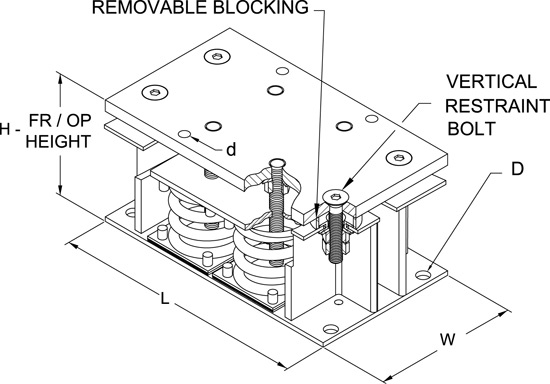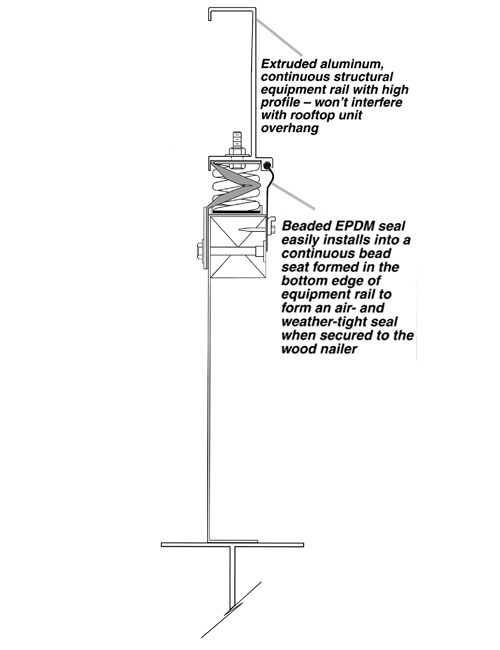This CE Center article is no longer eligible for receiving credits.
The growing number and severity of natural disasters within the U.S. in the past decade have caused untold tragedies and huge financial costs. Yet the majority of financial losses due to earthquakes and hurricanes in developed countries occur through the damage or failure of nonstructural components rather than failure of the building itself.
Nonstructural components, the name given to those items in a structure that are not part of the structural system, include mechanical, electrical and plumbing equipment plus the anchorage and attachments that connect components to the primary structural system. Losses resulting from nonstructural component failures have been estimated to exceed 50 percent of the total value of the structure.
One problem in the past was the lack of enforcement of seismic and wind restraint code provisions. A key finding by FEMA ((Federal Emergency Management Agency) regarding damage relief costs that have far exceeded expectations in the past 10-plus years was that if restraint requirements had not been waived, costs would have been significantly reduced. Another significant finding reported after a review of seismic events worldwide, is that moderate sized earthquakes in low seismic areas cause a tremendous amount of damage in structures that had little or no seismic protection.
Clearly, an understanding of seismic and wind restraint requirements and compliance is critical in this era of increasingly severe natural disasters.
Codes Relating to Seismic and Wind Restraints
Seismic and Wind Restraint Requirements are referenced in 2006/2009 IBC (International Building Code). The seismic restraint of mechanical, electrical and plumbing (MEP) nonstructural components is based on Chapter 13 Seismic Design Requirements for Nonstructural Components of ASCE (American Society of Civil Engineers) 7-05. ASCE 7-10 applies to the 2012 IBC code, and has been adopted by some states already.
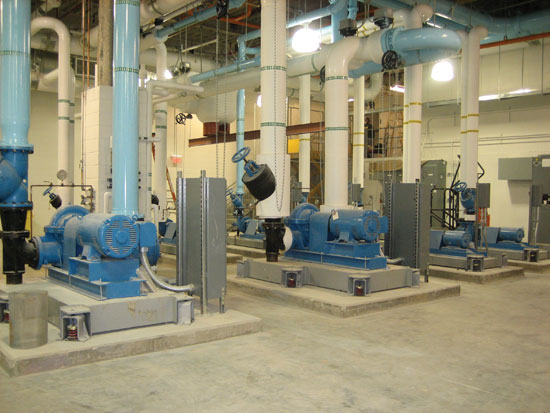 |
Concrete inertia bases with seismic/wind restraint in combination with a spring coil.
Photo courtesy of Kinetics Noise Control |
As with any design project, certain basic information provided by the building owner, architect, and structural engineer is required before seismic restraints can be selected and placed. This information should be included in the specification and bid package for the project and should also appear on the first sheet of the structural drawings and on the first sheet of the drawings for each MEP system.
 |
The US Geological Survey has mapped high, medium and low seismic hazard areas within the U.S.
Image courtesy of Kinetics Noise Control |
 |
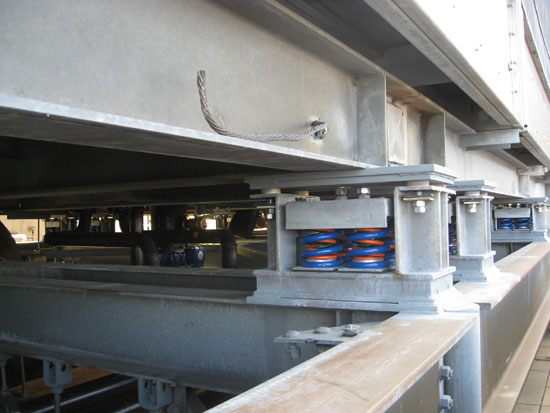 |
Examples of properly restrained HVAC rooftop equipment that survived the 1994 Northridge, California.
Photos courtesy of Kinetics Noise Control |
What Determines Seismic Restraint Requirements?
Several factors determine the need for seismic restraints:
* Occupancy Category
* Seismic Design Category
* Component Importance Factor
Occupancy Category
The nature of the building use, or its Occupancy Category, is determined by the building owner and the architect of record. In 2006 IBC the building use is defined through the occupancy category, which ranges from I to IV. Occupancy Category I and II is applied to buildings where failure presents a low hazard to human life, for example agricultural and minor storage buildings. Category III applies to high occupancy buildings such as schools and office buildings. At the other end of the range, Occupancy Category IV is applied to buildings, which are deemed to be essential for recovery after a disaster, such as hospitals, police stations and telecommunications centers.
Seismic Design Category
The Seismic Design Category is of great importance to everyone involved with MEP systems because it will determine whether seismic restraints are required or not, and if they qualify for exemption. Generally the structural engineer is responsible for determining the seismic design category for a project.
Seismic Design Category depends on:
*Occupancy Category (above)
*Long and Short Period Mapped Spectral Accelerations Parameters (SD1 and SDS)
SDS & SD1 are computed using the mapped long and short period spectral accelerations S1and SS respectively, and the project site class (below). S1 and SS values are mapped and can be obtained with the use of zip codes across the country and select international cities by the United States Geological Survey (USGS). The USGS also includes known fault lines into its calculated values. The worst case will be assigned to the project.
*Site Class
The type of soil and rock strata that directly underlies the building site. It ranges from A to F, progressing from the stiffest to the softest strata.
Long period values are generally applied to the buildings and other structures since they react more strongly to the long period excitation due to their relatively high mass and low stiffness. The code specifies the use of short period values when evaluating nonstructural components, such as pipe and duct, as they respond more strongly to the short period excitation due to their relatively low mass and high stiffness.
There are six seismic design categories that vary from A, the least stringent seismic restraint requirement to F, the most stringent,level of restraint required.*
Component Importance Factor
All MEP components must be assigned a Component Importance Factor that is designated as IP in the body of the code. This is done by the design professional who has responsibility for the MEP system in question. The design professional is also responsible for assigning the component importance factor to that system.
There are just two IP values for MEP components, 1.0 and 1.5, neither of which are directly linked to the importance factor for the building structure.
Value IP is 1.5 if the following life safety components are required to function after an earthquake:
- Fire suppression systems in all occupancy categories where specifics are addressed by the National Fire Protection Association (NFPA).
- Smoke evacuation systems in all occupancy categories.
- Every component in occupancy category IV buildings.
Value IP is 1.5 if components listed below contain hazardous (bio-hazardous) materials:
- Bio-hazardous lab exhaust fans and ducts.
- Process piping and equipment carrying flammable explosive or caustic material.
- Duct and attached equipment carrying flammable explosive or caustic material.
Value IP is 1.5 if components' failure would impair the continued operation or close an Occupancy Category IV facility. Even the failure of domestic water, sanitary and roof drain lines can flood a building and render it uninhabitable. So, all of the items listed above would typically apply to facilities in Occupancy Category IV, plus:
- Plumbing systems including drain, waste and vent lines.
- Air handling and conditioning systems.
- Electrical supply and control systems.
- Communication systems including servers and networks.
All other MEP systems that are not covered under items listed above may be assigned an IP component importance factor of 1.0.
The component importance factor is very important to the designer responsible for selecting and certifying the seismic restraints for an MEP system or component. It is a key indicator as to whether a particular component will qualify for an exemption or not. If a component importance factor has not been assigned to an MEP system, the designer must assume that it is equal to 1.5. This could result in an unnecessarily large increase in the size and number of restraints required along with a corresponding increase in the cost for the system if, in fact, the component importance factor could otherwise be assigned a value of 1.0.
| Seismic Restraints: A Summary |
Mechanical and electrical equipment knocked off of its supporting structure due to earthquake-related building movement can threaten both life and property. The cost of properly restraining this equipment is insignificant compared to the associated costs of replacing or repairing the equipment, the cost of system downtime as a result of seismic damage to the building services, and damage to the building contents.
A thorough analysis of seismic restraint hardware and seismic rated vibration isolators requires the consideration of four aspects of the system:
- Attachment of the Equipment to the Restraint
° The equipment must be securely attached to the restraint, and this attachment must demonstrate sufficient strength to withstand the imposed forces and to allow for transfer of seismic forces into the restraint.
- Restraint Design
° The strength of the seismic restraint must be sufficient to withstand the equipment-imposed forces. Manufacturers offer a wide variety of restraints suitable for many different applications.
- Attachment of Restraint to the Building Structure
° This attachment is typically via bolts, welds, or concrete anchors. In addition, the building attachment interface must be reviewed to ensure that it is capable of withstanding the imposed seismic forces. Typically this attachment is the 'weakest link' of the overall design, especially when post-installed concrete anchors are used.
- Equipment Fragility
° The ability of the equipment to continue to operate after being subjected to seismic force. Fragility information must be obtained from the equipment manufacturer.
|
General Code-based Exemptions
Exemptions are based on occupancy category, seismic design category and component importance factor.
MEP Components and Distribution Systems
Seismic restraints are not required or need not be “designed” for the following:
* MEP components if:
- The seismic design category is either A or B.
- The seismic design category is C and the component importance factor (IP) is 1.0. and its failure cannot impact the performance of an importance factor 1.5 component.
* Floor mounted MEP components in seismic categories D, E and F, if IP=1.0 and:
- Flexible connections are provided between the component and their services.
- The components are mounted at 4-ft or less above the floor level and weight 400-lbs or less.
* MEP distribution systems weighing 5-lb/ft or less in seismic design categories D, E, and F if IP=1.0.
In the above situations, “need not be designed” means that attachment using fasteners sized to fit any mounting holes in the equipment can be assumed to be adequate.
Additional Exemptions for Pipe
The exemptions and allowances for pipe can, with careful planning save a lot of time and money. They may also mean the difference between making a profit on a project and breaking even, or worse, losing money.
12-in. rule: seismic restraints are not required for pipe if it is mounted with a non-moment generating swivel type connection and all of the hangers in the run are 12-in. or less in length from the supporting structure; and no damage can occur from the expected swing of the pipe. (Restraints are required on equipment that is hung 12-in. or less from the ceiling because equipment behaves more erratically than piping or duct during a seismic event.)
Seismic restraints are not required:
- In seismic design category D, E or F with a component importance factor of 1.5, for pipes of a nominal size of 1-in. or less.
- In seismic design category D, E or F with a component importance factor of 1.0, for pipes of a nominal size of 3-in. or less.
- In seismic design category C with a component importance factor of 1.5, for pipes of a nominal size of 2-in. or less.
Other pipe exemptions apply to trapeze-supported pipe. See “Seismic exemptions for suspended trapeze supported pipe—IBC 2006/ASCE 7-05 (Summary)” available online from the Vibration Isolation & Seismic Control Manufacturers Association (VISCMA), Seismic Restraint of Hot Piping (www.viscma.com/Seismic_restraint_of_hot_piping.pdf).
Exemptions for HVAC Duct
As with the piping exemptions these exemptions and allowances for HVAC duct, can save a great deal of effort and money with careful planning..
The following exemptions will apply for duct if it's IP=1.0 and either of the following are met:
- All of the hangers in a run of duct are 12-in. in length from the top of the duct to the supporting structure and the hangers are detailed to avoid bending of the hanger ad its attachment.
- The ducts have a cross-sectional area of less than 6-sq ft.
The 2009 IBC code permits exemption for HVAC ducts with an IP=1.5 and a cross-sectional area of less than 6-sq/ft.
HVAC Duct Allowance
MEP components mounted inline with the duct system and hard connected to the duct on at least one end, weighing 75-lbs or less, may be restrained as though they were part of the duct system.
Electrical Exemptions
2006/2009 IBC code permits exemptions:
Where IP =1.0:
- All electrical components.
- Distribution systems. However, hangers anchored to concrete wedge-type expansion anchors must be used.
Where IP =1.5:
- Conduit that is less than 2.5-in. trade-size is exempt.
- Trapeze assemblies supporting conduit, bus ducts or cable trays that weight 10-lbs/ft or less are exempt.
In both cases above, if the hangers are attached to concrete, wedge-type expansion anchors must be used.
Existing buildings
Seismic restraint for retrofit projects are governed by state requirements. However, as a rule of thumb, it can be assumed that it will be required on the same basis as for new construction. If the seismic load on the building increases by more than 10 percent or the seismic capacity decreases by more than 5 percent, the structure will often need to be reinforced.
The entire A/E team is responsible for seismic restraint. The building structure must be able to handle the expected seismic loads generated by the MEP components, which, in turn must be restrained.
Selecting Restraints
Selecting restraints is most easily (and generally) performed by the manufacturer of seismic restraints. In order for manufacturers to select appropriate restraint components, design professionals should provide the following information:
* Listed on the first sheet of structural drawings:
1. Applicable building code, or codes
2. Seismic design category
1. SS or SDS short period acceleration.
2. Site class soil type
Noted on the specifications:
The seismic portion will alert the manufacturer's designer to any special considerations. of the restraint system.
Information for piping
- The component importance factor
- Piping layout with pipe sizes, connections and materials.
- Whether the piping is for domestic hot water, domestic cold water, medical gas, natural gas, vacuum, drain, waste or vent.
- Identification of any piping runs that are to be trapeze supported.
Information for equipment
- The component importance factor
- Cut sheets with complete dimensions and, if applicable, mounting locations.
- Operating weight and center of gravity of the equipment.
- The building height and where the equipment actually attaches to the building.
| Typical Seismic and Wind Restraint for HVAC Equipment |
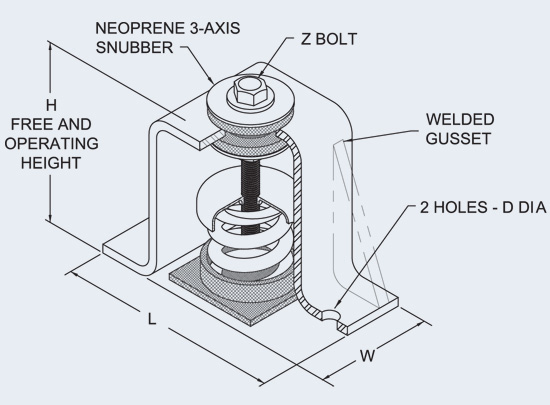 |
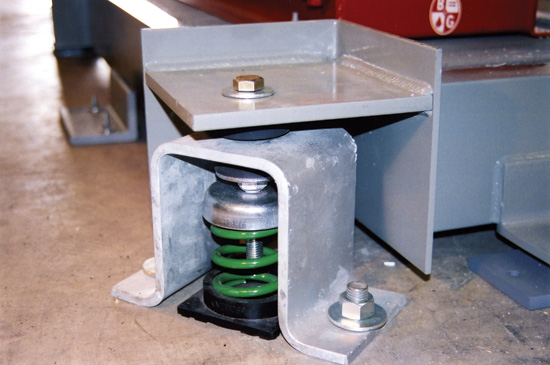 |
Drawing and photo of Seismic Control Spring Isolators
Images courtesy of Kinetics Noise Control |
Post-type three-axis coiled spring isolator and seismic and wind restraint may be used for indoor and outdoor floor mounted fans, pumps, air compressors and other mechanical equipment. It provides all-directional restraint with vertical limit stops. Motion during an earthquake, which would otherwise displace life support and emergency equipment is limited to 0.25-in. in all directions. The steel housing assembly limits both lateral and vertical movement of the supported equipment without degrading the vibration isolation of the spring during normal equipment operating conditions. Properly selected, this type of isolator provides adequate restraint against code-based seismic and wind forces required by code.
|
Anchorage of MEP Components
The purpose of a seismic restraint is to form a load path between the MEP component and the building structure. It must be attached to a portion of the building structure that is capable of carrying the expected seismic loads.
Research has shown that the force generated in a building increases as one rises through the structure. Surprisingly, the total height of the structure is not as important a factor as is the location of equipment in that structure relative to the roof. The IBC Code addresses this condition by requiring that the design used when specifying equipment anchorage includes forces that increase by a factor of three as equipment locations move upward from grade to the roof.
It is most cost effective to locate heavy equipment at lower levels within the building envelope wherever feasible. However, as recent disasters such as Hurricane Sandy have shown, serious damage resulting from flooded equipment located on grade or below, far outweighs the savings from installing equipment on lower levels.
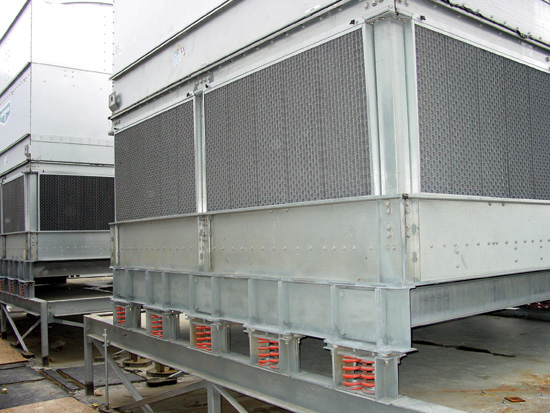 |
Typical rooftop plate-type three-axis seismic restraint can be specified for isolating equipment carrying a large fluid load, which may be drained, such as boilers and chillers.
Photo courtesy of Kinetics Noise Control |
Anchorage of Pipe and Duct to Concrete
Concrete has long been identified as a weak point when used in areas exposed to seismic events. The addition of anchorage holes in the concrete provides locations for stress cracks to develop. These cracks open up and allow conventional anchors to easily pull out. Because of the requirement, post-installed seismically rated anchors are required. Both 2006 IBC and 2009 IBC require that the concrete anchors for seismic applications must be pre-qualified per ACI (American Concrete Institute) 355.2 (ICC AC 193 (International Code Council Acceptance Criteria) and have an ICC-ESR Evaluation Service report. Ratings vary by size and by anchor manufacturer. It is critical that the restraint system design specifies a particular anchor by size and source and that the anchor used conforms to this specification.
Additional Anchorage Limitations
Fasteners that rely on friction that results from gravity-based forces are not permitted to be used for seismic restraints. These include:
- Power-actuated fasters, such as powder shot pins. These fasteners rely on the elastic nature of the material into which they are driven to provide enough friction force to prevent withdrawal under a tensile load. During a seismic event, vibration may cause them to back out.
- Non-qualified friction clips which rely on friction for their holding power.
- Friction due to gravity loads.
- Drop-in-concrete anchors with an internal thread and expansion core.
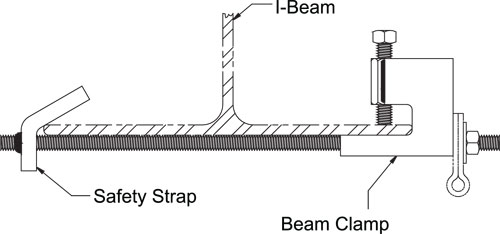 |
A beam clamp may be used for restraint if it includes a safety strap.
Drawing courtesy of Kinetics Noise Control |
Beam Clamps
Typical beam clamps rely strongly on friction to hold their position and are designed to support primarily vertical loads. However, if they include a safety strap that can resist a seismic load, they may be used for restraint.
Mechanical Equipment Over 10 HP
The 2006 and 2009 IBC require that non-isolated mechanical equipment over 10 HP will require undercut anchors that fit into a groove cut at the base of the anchor pocket, or anchors that are adhered in the anchor pocket using a seismically qualified adhesive material.
Housekeeping Pads
Housekeeping pads are often added to increase slab thickness in order to provide a reasonable embedment depth for larger diameter anchors and to allow clear areas around equipment for maintenance and cleaning.
- Since the code requires that anchors be embedded in a monolithic pour, the pad must be poured concurrently with the structural floor slab, or that a separate pad is added that is independently thick enough to meet the requirement (more common).
- The housekeeping pad must be adequately reinforced and doweled to the structural slab with sufficient connections to ensure that it will neither shatter nor come loose from the floor during a seismic event.
 |
Example of a connector that fastens cables used in the seismic restraint of piping, duct, electrical cable trays, and suspended equipment.
Photo courtesy of Kinetics Noise Control |
Helpful Rules for Restraining Pipe and Duct
Failures in piping systems due to code non-compliance that have led to the release of water or other fluids have been found to be the cause of most of the monetary damage to buildings and contents during seismic events.
Transverse and Longitudinal Restraints
There are two basic types of restraints:
- Transverse (T) restraints, which act perpendicular to the pipe.
- Longitudinal restraints (L), which act along the pipe.
Transverse and longitudinal restraints may be placed at the same location and designated (TL).
Transverse restraints may be either cables or struts. Although they look similar, they behave very differently in practice. Cables carry only tension loads (cables cannot be pushed). Struts carry both tension and compression loads.
In general, piping restrained by struts will require one strut for each type of restraint at each location. Since they can be fitted to one side only, struts allow for a more narrow packaging arrangement.
Piping restrained with cables may take up more space than is available. Cable restraint requires that two cables be fitted 180° apart for each type of restraint at each location.
The cable or strut restraint installation angle may be between 0° and 60° as measured from the horizontal.
Because struts subject hanger rods to tensile loads in conjunction with the static weight loads, the number of restraint points needed on a given run of piping will typically be considerably higher for a strut-restrained system than for the cable-restrained system. In addition, the use of struts subjects the anchorage for the hangers at the strut locations to become part of the seismic restraint system; this means that the struts will need to be fitted with seismically rated anchors. The net result is that strut-restrained systems will be more costly to install.
An added factor to consider when selecting a restraint system is that once a decision is reached on the type to use for a particular run, code requirements state that the same type of system must be used for the entire run (all cable or all strut).
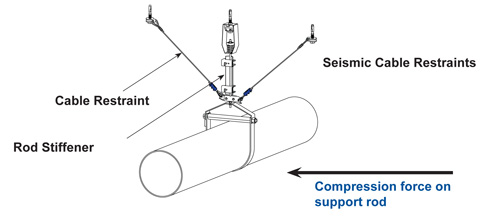 |
 |
Struts are loaded in compression, which makes the hanger rod part of the seismic load path. Cables can only be loaded in tension, which means the hanger rod and its anchorage are not part of the seismic load path.
Images courtesy of Kinetics Noise Control |
Seismic forces load the strut in compression resulting in a tensile load on the hanger rod. This results in the hanger rod and its anchorage becoming part of the seismic restraint load path. The hanger rod must, therefore, be installed using a seismically rated anchor that includes such requirements as use of wedge-type anchors and minimum embedment depths (mentioned above).
Cables, on the other hand, can only be loaded in tension, which, means that seismic forces can only generate compressive loads in the pipe hanger rod and its anchorage, which are not part of the seismic load path. The hanger rod in this case do not require a seismically rated anchor at hanger support locations. Straps and cables may not be used as hangers at restraint locations.
Transverse and longitudinal restraints must be placed within 4 inches of a hanger location. This will ensure that the vertical reactions are transmitted to the hangers rather than bending the pipe or duct. The hanger itself at restraint locations must be a rigid member capable of carrying compression loads.
 |
Restraint requirements for vertical drops depend on H (horizontal run) and S (transverse restraint spacing).
Image courtesy of Kinetics Noise Control |
Vertical Drops
A vertical drop describes pipe that normally extends down from an overhead run of pipe and connects to a piece of equipment, usually through some type of flexible coupling connector. The drop can also extend horizontally. If the pipe drop is less than or equal to one half the transverse restraint spacing, no further restraint is required provided that there is a transverse restraint at the end of the horizontal run.
 |
The restraint installation angle for transverse and longitudinal cable and strut restraints may be between 0° and 60°as measured from the horizontal.
Image courtesy of Kinetics Noise Control |
 |
Longitudinal restraints may be attached to the pipe with a pipe clamp slightly rotated to miss the hanger rod.
Image courtesy of Kinetics Noise Control |
Strut type longitudinal restraints may also be attached to the pipe with a pipe clamp, which is rotated to miss the hanger rod. As with the transverse restraints, the installation angle may vary from 30° up to a maximum of 60°.
 |
Hanger rods, which are very long or very small in diameter, may require rod stiffeners to prevent buckling.
Image courtesy of Kinetics Noise Control |
Hanger rods for isolated pipe at restraint locations must be fitted with uplift limit stops applied to the hanger rod just below the isolation hanger. Typically this consists of a nut and washer, which are adjusted to provide a gap not to exceed ¼-in. between the washer and the bottom of the isolation hanger. When top mounted cushions of neoprene or fiberglass are provided, a gap, not to exceed ⅛-in. is required at the top of the isolation hanger. This treatment is valid for all isolated pipe and duct.
 |
Isolation hangers at seismic restraint locations are fitted with uplift limit stops.
Image courtesy of Kinetics Noise Control |
Hot Water Pipe Restraint
Hot piping, whether it is steam or domestic hot water, presents certain problems when designing seismic restraints due to the fact that the piping grows in length as it heats up. Only one longitudinal restraint is permitted on a run to avoid problems created by the expansion of the pipe. Runs that are longer than the permitted longitudinal restraint spacing will require an expansion compensator to allow additional longitudinal restraints.
Restraint Attachment
Unless provisions are made for relative movement, the pipe restraints must be attached at approximately the same elevation in the building as the pipe hangers.
Consequential Damage
Piping and systems or equipment that could normally have a component importance factor of 1.0, but which are suspended above life safety or essential systems such as fire protection sprinkler piping, must be shielded from the higher importance system or be redesignated as having a component importance factor of 1.5 and be restrained accordingly.
 |
Typical no-hub type coupling
Image courtesy of Kinetics Noise Control |
Drain, Waste and Vent Pipe
Waste, drain, and vent lines typically do not hold pressure; nor do they run completely full all the time. They are mostly manufactured from materials such as cast iron, steel, or PVC plastic that are brittle and have low deformability. They are traditionally connected by slip hub-type type fittings. Hub-type pipes have a hub on one end with an I. D. that is just slightly larger than the O. D. of the pipe. Therefore, extra care must be used when restraining them.
Heavy-duty no-hub pipe couplings should be used for seismic applications, where no-hub pipes are joined together with a flexible coupling that slips over the O. D. of the pipes and is clamped with band clamps.
Wind Restraint Requirements
Any component of piece of equipment that is exposed in any way to the effects of wind should be restrained. There are no exemptions for exposed components.
Codes Relating to Wind Restraint
The relevant portions of the codes include:
2006/2009 IBC Section 1609.1: “Buildings, structures and parts thereof shall be designed to withstand the minimum wind loads prescribed herein. Decreases in wind loads shall not be made for the effect of shielding by other structures.”
2006/2009 IBC Section 1609.1.1: Wind loads on every building or structure shall be determined in accordance with ASCE 7-Chapter 6, which describes procedures for determining design wind loads.
2006/2009 IBC Horizontal Design Wind Load is defined by ASCE7-05 Sections 6.5.15 & 6.5.15.1, and is roughly twice that specified in 2003 IBC.
2006/2009 IBC Design Wind Uplift Load is recommended by
ASCE 7-05 Section C6.5.11 (page 300). It is a function of the location of the equipment on a roof with the corner areas being most severe. For estimating purposes it can be estimated as slightly greater than half the horizontal design load.
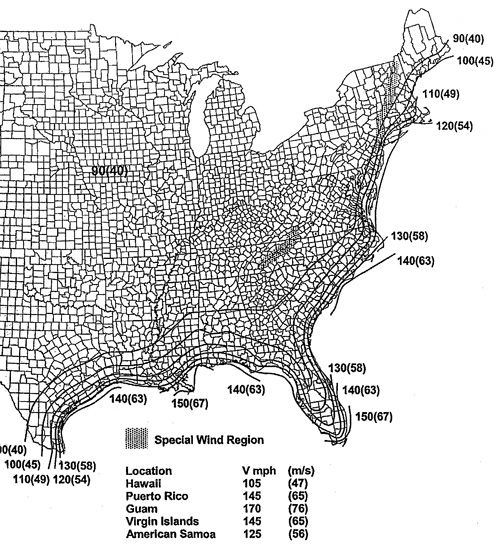 |
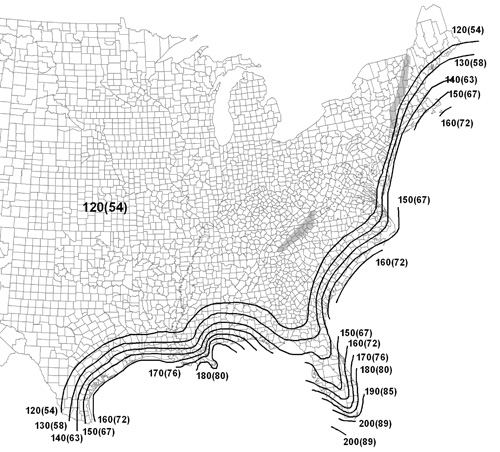 |
Current wind restraint requirements are based on 2006/2009 IBC Basic Wind Speeds. Future requirements in 2012 IBC will be more rigorous.
Source: ASCE 7-05, figure 1 |
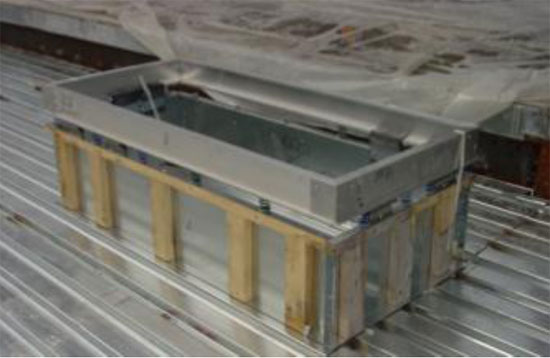 |
Typical all-in-one curb and vibration isolation restraint for under-20-ton packaged rooftop units that meets seismic and wind load requirements. Unless specified otherwise, typical restraints are selected to resist 43-psf horizontal and 25-psf vertical wind loads.
Images courtesy of Kinetics Noise Control
|
Selecting Wind Restraints
The same types of restraints and anchors used for seismic conditions are also used for wind applications. As with seismic restraints, the selection of wind restraints is most easily and typically performed by the manufacturer of the restraints.
Information Needed by the Manufacturer of Wind Restraints
From the first sheet of the structural and architectural drawings.
- The applicable building code or codes. (Cited above.)
- Exposure category.
B. Urban/suburban areas with numerous closely spaced obstructions having the size of a single-family house or larger.
C. Flat, open terrain, open hurricane zone.
D. Flat, open non-hurricane zone.
- Design wind speed.
Wind speed used in design is often referred to as a “3-second gust” which is the highest sustained gust over a 3 second period having a probability of being exceeded per year of 1 in 50 (ASCE 7-05). Windspeedbyzip maps out the design wind speed as suggested by ASCE 7-05 for the United States. Future wind speed requirements listed in the 2012 IBC are higher.
- Mean building height.
Mean building height is the vertical distance from the grade plane to the average height of the highest roof surface.
Required equipment information:
- Equipment cut sheets with complete dimensions and, if applicable, mounting locations.
- Operating weight of the equipment.
- Dunnage and support steel height, if applicable.
- Structure that the equipment is attached to, for example, concrete, wood or steel.
Great care must be taken in the design, selection, and installation of supports and restraints for roof top curb mounted equipment since, as mentioned above, equipment that is mounted on the roof of a building will have design seismic forces that are three times larger than a similar piece of equipment mounted on grade.
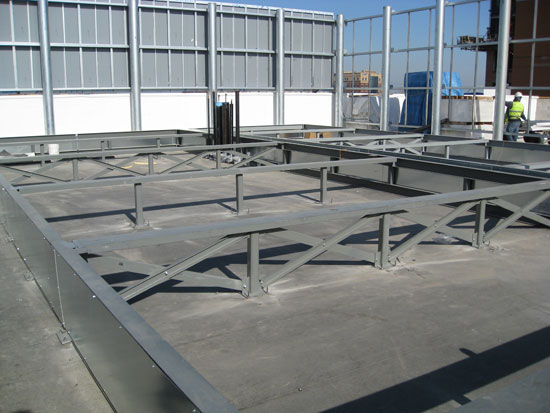 |
Non-isolated seismic/wind restrained roof curb.
Photo courtesy of Kinetics Noise Control |
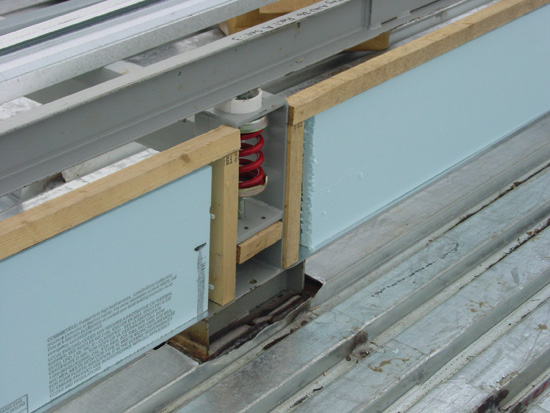 |
Example of a seismic/wind restrained vibration isolation roof.
Photo courtesy of Kinetics Noise Control |
Conclusion
Increasingly rigorous code requirements relating to seismic and wind restraints for MEP equipment and components are making buildings safer and reducing financial losses in the event of natural disasters. But specifying restraints is a complex matter that demands mastery and experience of the several factors that determine the type and category of restraints required. Manufacturers of restraints can provide valuable input for design professionals who already have an understanding of the principles involved.
 |
Celebrating over 50 years, Kinetics Noise Control has extensive experience in designing and manufacturing innovative products to control sound and vibration. Established in 1958 as engineers focusing on sound and vibration control, Kinetics pioneered development of pre-compressed, molded fiberglass pad isolators that would be incorporated into an innovative new floor isolation system. Previous trade names of Kinetics Noise Control include Consolidated Kinetics and Peabody Noise Control. www.kineticsnoise.com |











